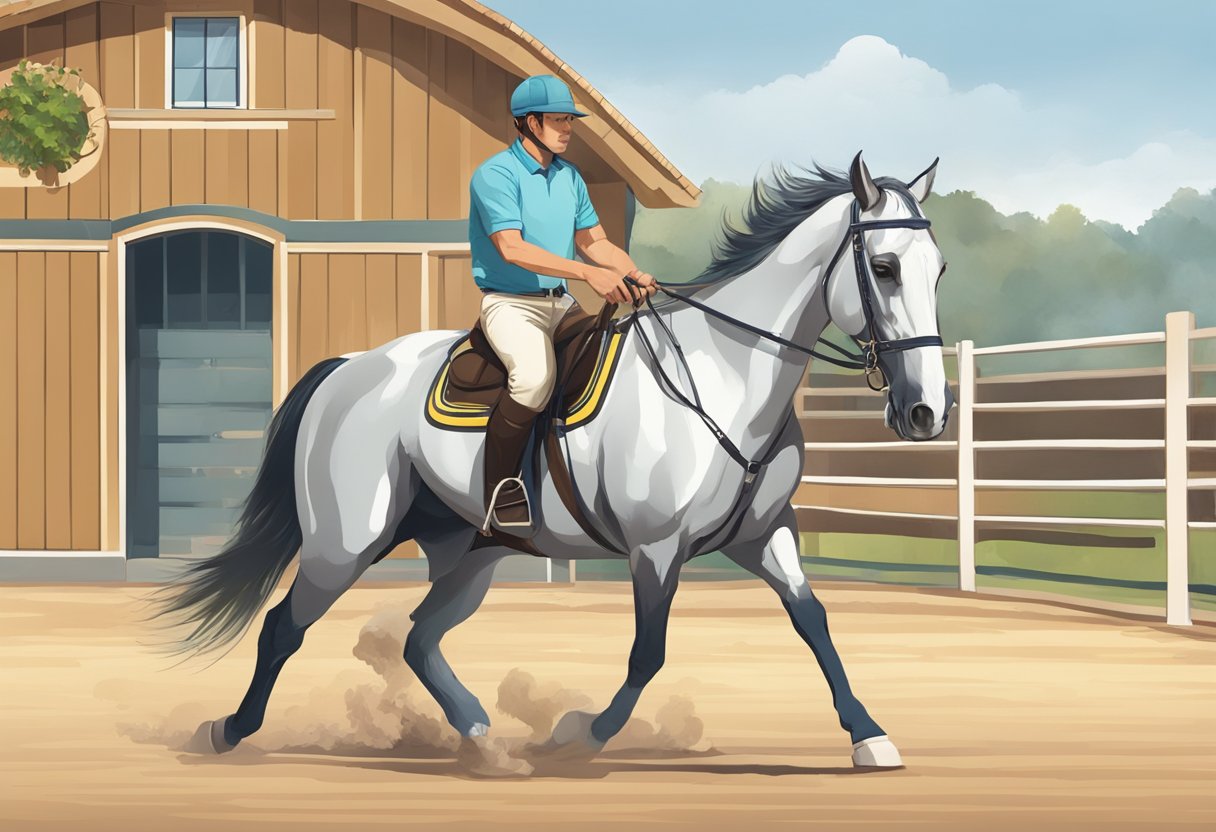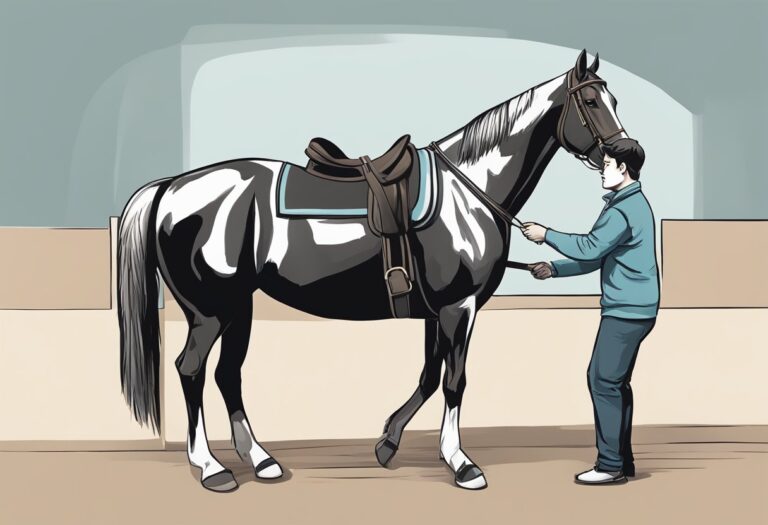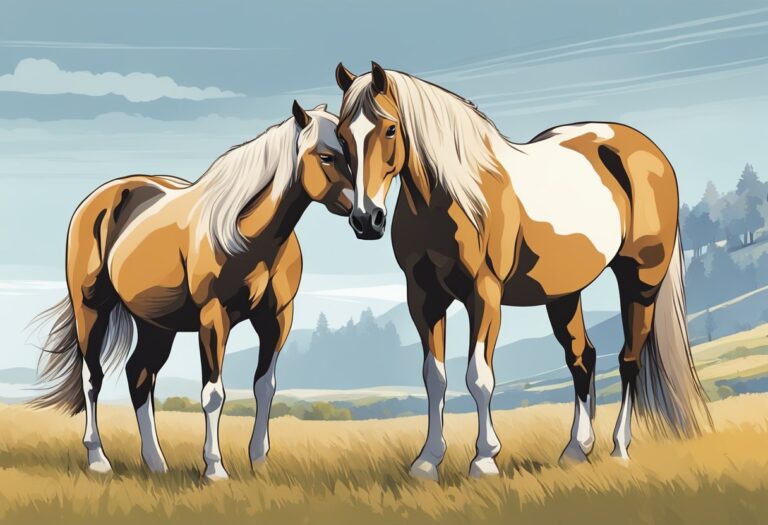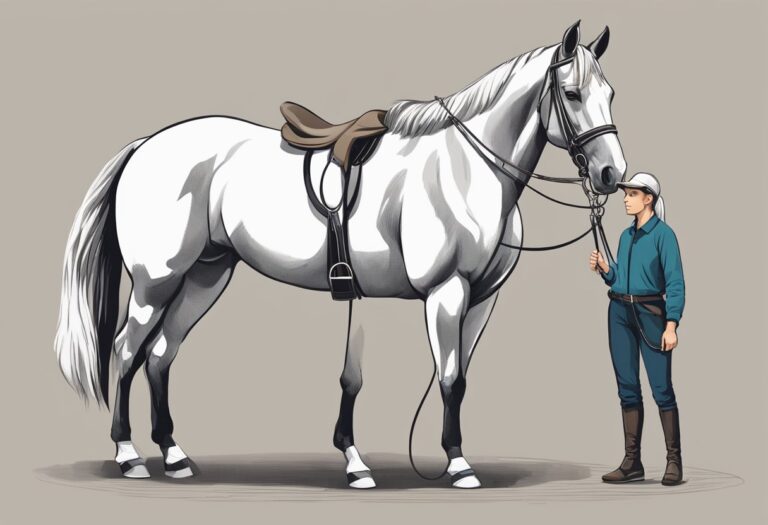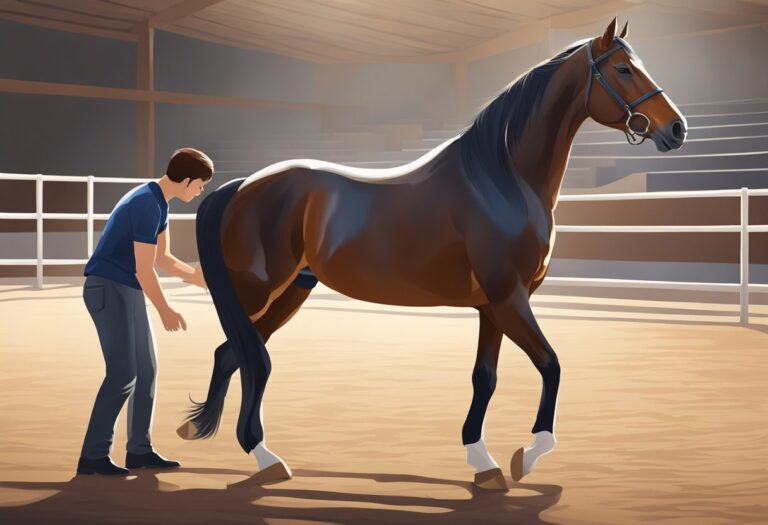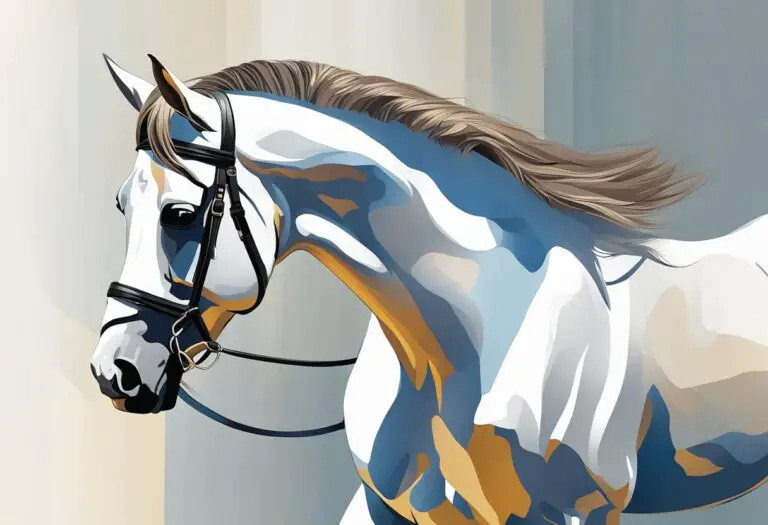What is Clicker Training for Horses? Explained
Clicker training is a form of positive reinforcement training that involves the use of a clicker to mark desired behaviors in animals. This type of training has become increasingly popular in recent years, as it is a gentle and effective way to train horses and other animals. Clicker training for horses involves using a clicker to mark the desired behavior, followed by a reward such as a treat or praise.
The goal of clicker training is to teach the horse to associate the sound of the clicker with a reward, so that they will repeat the desired behavior in order to receive the reward. This type of training is based on the principles of operant conditioning, which involves rewarding desired behaviors and ignoring or redirecting undesired behaviors. Clicker training is a gentle and effective way to train horses, as it focuses on positive reinforcement rather than punishment or force.
Basics of Clicker Training

Defining Clicker Training
Clicker training is a positive reinforcement training method that uses a marker signal, such as a clicker, to communicate to the horse that they have performed the desired behavior. The clicker is a small device that makes a distinct sound when pressed, and it is used to mark the precise moment the horse performs the desired behavior. The horse then receives a reward, such as a treat or praise, for performing the behavior.
Benefits for Horses
Clicker training has several benefits for horses. First, it is a gentle and humane training method that does not involve physical punishment or force. Instead, it focuses on rewarding the horse for good behavior, which encourages the horse to repeat the behavior in the future. Clicker training also helps to build a strong bond between the horse and the trainer, as it requires the trainer to pay close attention to the horse’s behavior and respond quickly and accurately with the clicker.
Key Principles
There are several key principles that are important to understand when using clicker training with horses. First, the timing of the clicker is critical. It must be used to mark the precise moment the horse performs the desired behavior, so the horse understands exactly what they are being rewarded for. Second, the rewards used in clicker training should be highly desirable to the horse, such as their favorite treats or praise. This helps to motivate the horse to perform the desired behavior.
Finally, it is important to start with simple behaviors and gradually build up to more complex behaviors. This allows the horse to learn at their own pace and ensures that they understand each step of the training process before moving on to the next. With patience and consistency, clicker training can be a highly effective and rewarding method for training horses.
Getting Started with Clicker Training

Clicker training is a positive reinforcement-based training method that uses a clicker as a marker signal to communicate with the horse. It is a popular training method used by many horse trainers and owners to teach new behaviors and reinforce existing ones. The following subsections will guide you through the basics of getting started with clicker training.
Choosing a Clicker
The first step in clicker training is to choose a clicker. Clickers come in different shapes and sizes, but the most common type is a small plastic box with a metal button that makes a distinct clicking sound. It is important to choose a clicker that is comfortable to hold and easy to use.
Initial Conditioning
Before starting clicker training, the horse must be conditioned to associate the clicker sound with a reward. This is done by repeatedly clicking the clicker and immediately giving the horse a treat. The horse will soon learn that the clicker sound means a reward is coming, and will start to anticipate the clicker sound.
Setting Training Goals
Once the horse is conditioned to the clicker, you can start setting training goals. It is important to set achievable goals that are specific, measurable, and realistic. Examples of training goals include teaching the horse to stand still for mounting, walk calmly on a lead rope, or perform a specific riding maneuver.
In summary, clicker training is a positive reinforcement-based training method that can be used to teach new behaviors and reinforce existing ones. Choosing a clicker, initial conditioning, and setting training goals are essential steps in getting started with clicker training.
Training Techniques

Positive Reinforcement
Clicker training for horses relies heavily on positive reinforcement. This means that the trainer rewards the horse for exhibiting desirable behavior. The reward can be in the form of a treat, verbal praise, or physical affection. The clicker is used to mark the exact moment when the horse exhibits the desired behavior. This helps the horse understand what behavior is being rewarded.
Shaping Behavior
Shaping behavior is another technique used in clicker training for horses. This involves breaking down a complex behavior into smaller, more manageable steps. The trainer rewards the horse for each step until the horse can perform the entire behavior. This helps the horse learn the behavior in a gradual and non-stressful way.
Cueing and Commands
Cueing and commands are also important in clicker training for horses. The trainer uses a specific cue or command to signal to the horse what behavior is expected. The clicker is used to mark the exact moment when the horse exhibits the desired behavior in response to the cue or command. Over time, the horse learns to associate the cue or command with the desired behavior.
In summary, clicker training for horses uses positive reinforcement, shaping behavior, and cueing and commands to teach the horse new behaviors. These techniques are effective and humane ways to train horses without using force or punishment.
Common Exercises

Clicker training for horses involves a variety of exercises that can help improve their behavior and performance. Some of the most common exercises include:
Target Training
Target training involves using a target, such as a ball or cone, to teach a horse to touch or follow the target with its nose. This exercise can be used to teach a horse to stand still, move forward, or turn in different directions. It can also help improve a horse’s focus and attention.
To start target training, the horse should be introduced to the target and allowed to sniff or investigate it. Once the horse is comfortable with the target, the trainer can begin using the clicker to mark the behavior of touching or following the target. Over time, the horse will learn to associate the sound of the clicker with a reward, such as a treat or praise.
Leading and Haltering
Leading and haltering are essential skills for any horse to learn. Clicker training can be used to teach a horse to lead calmly and obediently, and to stand still while being haltered or groomed.
To teach a horse to lead, the trainer can use the clicker to mark the horse’s behavior of walking calmly beside them. If the horse pulls or tries to run ahead, the trainer can stop and wait for the horse to calm down before continuing. Over time, the horse will learn to associate the sound of the clicker with the desired behavior of walking calmly on a lead.
Trailer Loading
Trailer loading can be a challenging and stressful experience for many horses. Clicker training can be used to teach a horse to load calmly and confidently into a trailer.
To start trailer loading, the horse should be introduced to the trailer and allowed to sniff or investigate it. The trainer can then use the clicker to mark the horse’s behavior of approaching or stepping into the trailer. Over time, the horse will learn to associate the sound of the clicker with the reward of treats or praise for loading into the trailer.
By using clicker training to teach these common exercises, horse trainers can help improve their horse’s behavior and performance in a positive and rewarding way.
Advanced Clicker Training

Overcoming Behavioral Issues
Clicker training can be a powerful tool to help horses overcome behavioral issues. For example, if a horse is prone to bucking or rearing, clicker training can be used to reinforce calm behavior and discourage the unwanted behavior. By clicking and treating the horse when it is calm, the horse learns that calm behavior is rewarded, and is more likely to exhibit this behavior in the future.
Another way to use clicker training to overcome behavioral issues is to teach the horse an alternative behavior. For example, if a horse is prone to biting, clicker training can be used to teach the horse to touch its nose to a target instead. By reinforcing this behavior with a click and a treat, the horse learns that this behavior is more rewarding than biting.
Teaching Complex Tricks
Clicker training can also be used to teach horses complex tricks. One way to do this is to break the trick down into smaller, more manageable steps. For example, if you want to teach a horse to bow, you might start by clicking and treating the horse for putting its head down. Once the horse has mastered this step, you can click and treat for the horse lowering its chest, and so on.
Another way to teach complex tricks is to use shaping. Shaping involves clicking and treating the horse for behaviors that are progressively closer to the desired behavior. For example, if you want to teach a horse to pick up a hat, you might start by clicking and treating the horse for touching the hat with its nose. Once the horse has mastered this step, you can click and treat for the horse picking up the hat with its mouth, and so on.
Overall, clicker training can be a powerful tool for advanced training techniques with horses. By breaking down behaviors into smaller steps and using positive reinforcement, horses can learn complex behaviors and overcome behavioral issues.
Safety Considerations

When it comes to clicker training for horses, safety should always be the top priority. Here are some important safety considerations to keep in mind:
1. Choose a Suitable Environment
Before starting clicker training, it’s important to choose a suitable environment. The area should be free from distractions, such as other horses, loud noises, or sudden movements. A safe and secure training area is essential to prevent accidents and ensure that the horse remains focused on the training.
2. Use Proper Equipment
Using the right equipment is crucial for the safety of both the horse and the trainer. Make sure that the horse is wearing a well-fitting halter or bridle and that the lead rope or reins are in good condition. Additionally, trainers should wear appropriate footwear and protective gear to prevent injuries.
3. Start Slowly and Progress Gradually
Clicker training should always start slowly and progress gradually. Trainers should never rush the process or push the horse beyond its limits. It’s important to take the time to build a strong foundation of trust and understanding between the horse and trainer before moving on to more advanced training.
4. Monitor the Horse’s Behavior
During clicker training, it’s important to monitor the horse’s behavior closely. If the horse becomes agitated, stressed, or uncomfortable, the training should be stopped immediately. Trainers should also be aware of any signs of pain or discomfort, such as limping or flinching, and seek veterinary attention if necessary.
5. Consult with a Professional Trainer
Finally, it’s always a good idea to consult with a professional trainer before starting clicker training. A qualified trainer can provide guidance and advice on the best training methods and techniques for your horse, as well as help ensure that the training is safe and effective.
Troubleshooting Common Problems

Clicker training for horses can be an effective and positive way to train horses, but like any training method, it can have its challenges. Here are some common problems that may arise during clicker training and how to troubleshoot them:
Problem: Horse Not Responding to Clicker
If the horse is not responding to the clicker, it may be because they do not understand the association between the click and the reward. In this case, it may be helpful to go back to the basics and start with simple tasks, such as targeting or touching a target stick. It’s important to make sure that the horse is clear on what behavior is being rewarded.
Problem: Horse Becomes Overexcited or Aggressive
Some horses may become overexcited or even aggressive during clicker training, especially if they are highly motivated by food rewards. In this case, it’s important to take a step back and assess the situation. It may be necessary to adjust the training plan and use a different reward, such as scratches or verbal praise, instead of food. It’s also important to make sure that the horse is not being pushed too far too fast and that the training sessions are kept short and positive.
Problem: Horse Becomes Bored or Disinterested
If the horse becomes bored or disinterested during clicker training, it may be because the training sessions are too repetitive or not challenging enough. It’s important to mix things up and introduce new tasks or challenges to keep the horse engaged. It’s also important to make sure that the horse is not being overworked and that the training sessions are kept short and positive.
By troubleshooting common problems that may arise during clicker training, horse owners and trainers can ensure that their training sessions are effective, positive, and enjoyable for both the horse and the human.
Measuring Progress and Success

Clicker training for horses is a highly effective method of training that can produce great results when done correctly. Measuring progress and success is an important aspect of clicker training, as it allows the trainer to track the horse’s development and make adjustments to the training plan as needed.
One way to measure progress is through the use of a training log. This log should include information such as the date of each training session, the specific behaviors that were targeted, and the horse’s response to each training session. By keeping track of this information, the trainer can identify patterns and trends in the horse’s behavior, and adjust the training plan accordingly.
Another way to measure progress is through the use of a clicker training goal sheet. This sheet should include a list of specific behaviors that the trainer wants the horse to learn, along with a timeline for when each behavior should be mastered. By setting clear goals and tracking progress towards those goals, the trainer can ensure that the horse is making steady progress and is on track to reach its full potential.
In addition to these methods, it is important to use positive reinforcement to motivate the horse and reward it for its progress. This can include treats, verbal praise, or other forms of positive reinforcement that the horse finds rewarding. By using positive reinforcement consistently and effectively, the trainer can create a positive learning environment that encourages the horse to learn and grow.
Overall, measuring progress and success is an important part of clicker training for horses. By tracking progress, setting clear goals, and using positive reinforcement, trainers can help their horses reach their full potential and achieve success in a safe and effective manner.

